Dictator of All Designs and a "Waterfall"
- Aistė

- Feb 27, 2020
- 10 min read
Updated: Mar 13, 2020
When I begin to work on the next design, the first thing I do, I pick up the stitch pattern. Then I always ask myself a question of what opportunities or obstacles for performing design tasks this stitch pattern brings and how best to reveal its capabilities. Designing never happens in such order: choosing the shape and the purpose, picking-up the yarn and trying after all to impose a stitch pattern. In my personal opinion and relying on my experience, the sequence of steps should be quite the opposite. First, we pick up a stitch pattern. The next step is to find the yarn, which unveils the stitch pattern the best way possible, and only then the shape and the purpose follow, relying on the possibilities and limitations that the selected stitch pattern brings us. And often we encounter the fact that not all stitch patterns are suitable for the chosen design (style, type, purpose). Here we can conclude – the stitch pattern dictates the design.
What do we need from a stitch pattern when we are working on the design so that it allows a flat two-dimensional piece to turn into a three-dimensional figure? Here the simplest knitting techniques come in handy: decreases and increases for changing the width and short rows for adjusting the length (in sideways knitting – vice versa). Next, we can analyze whether the chosen stitch pattern allows us to implement these techniques or not. The simpler the stitch pattern, the more flexible it is, the more complicated it is, the more resistant it is to shaping and modeling.
As for me, I identified four groups of stitch patterns.
***
Когда я начинаю работать над очередным дизайном, первое, что я делаю – я выбираю узор. Потом спрашиваю себя, какие возможности или преграды для выполнения конструктивных задач приподносит выбранный узор и как наилучшим образом раскрыть его возможности. Работа над дизайном никогда не происходит таким чередом: выбор формы и предназначения, выбор пряжи и пробование после всего наложить узор. По моему личному убеждению и опыту, ход мыслей должен быть противоположным. Сначала выбирается узор, для него подбирается пряжа, наилучшим образом раскрывающая узор, и только потом подбирается форма, полагаясь на возможности и ограничения, которые нам приподносит понравившийся узор. И часто сталкиваемся с тем, что далеко не все узоры подходят для выбранной формы (фасона, типа, предназначения). Вывод один – узор диктует дизайн.
Что нам нужно от узора, когда мы работаем над дизайном? Чтобы он позволял плоское двухмерное полотно превратить в трехмерную фигуру. Для этого в вязании используются самые простые приемы: убавления и прибавления для изменения ширины и укороченные ряды для изменения длины (если изделие связано поперек – наоборот). Далее происходит анализ, позволяет ли выбранный нами узор или рисунок внедрить эти приемы. Чем узор проще, тем он гибче, чем он сложнее, тем он более стойкий моделированию.
Для себя я определила четыре группы узоров.
1. Simple stitch patterns. Простые узоры
Simple stitch patterns do not limit the flight of imagination. They allow you to translate all the designed shapes and styles, no matter how intricate they would be. That is the Stockinette and the reverse Stockinette stitch, moss stitch pattern, seed stitch pattern, garter stitch, patterns with short repeats (no more than four stitches and rows), or stitch patterns where the Stockinette stitch is prevalent. Some moments need to be taken into account, say, double decreases/increases in a seed or a moss pattern, as well as a shift by one row in short rows, but in general, these patterns do not become design dictators. We can say that you have a piece of fabric; all you need to do is to cut out a certain desired shape according to a pre-drawn and a pre-calculated blueprint.
***
Простые узоры не ограничивают полет фантазии. Они позволяют воплотить все задуманные формы и фасоны, какими сложными они бы не были. Это лицевая или изнаночная гладь, жемчужный узор, рис, платочная вязка, узоры с мелким раппортом (не больше 4 петель и рядов) или узоры, где гладь доминирует. Есть некоторые моменты, которые нужно учесть, скажем, двойные убавления/прибавления в рисовом или в жемчужном узоре, также смещение на один ряд в укороченных рядах в мелких узорах, но в целом эти узоры не становятся диктаторами дизайна. Можно сказать, что у вас есть отрезок ткани. Остается вырезать из нее некую желаемую форму по заранее начерченной и рассчитанной выкройке.
2. Horizontal and striped stitch patterns. Горизонтальные узоры и полосатые рисунки
In striped and horizontal patterns, there are no problems when it comes to changing the width of the piece with increases and decreases. The main challenge here arises with the lengthening the piece with short rows. If the stripes of the pattern are thin, the short rows absorb several pattern repeats. If the stripes are wide, the short rows should be placed in one repeat of the stitch pattern or repeatedly in several. It is clear that the flight of imagination here is already limited, and it takes a lot of effort to find a way out. Examples of such situations could be scattered bust darts, symmetrical short rows in a striped garter stitch, placement of a bust dart in the underarms, the fully-fashioned shoulder, interruption of stripes on shoulders, changing the width of some stripes. For all this complexity, I like stripes and horizontal stitch patterns a lot, but each case needs an individual approach, and there are no general rules.
***
В полосатых и горизонтальных узорах нет никаких проблем с изменением ширины полотна убавлениями и прибавлениями. Основной вызов здесь возникает с изменением длины деталей укороченными рядами. Если полосатость узора мелкая, укороченные ряды поглощают несколько раппортов узора. Если полосатость узора крупная, укороченные ряды должны разместиться в одном раппорте узора или же повторно в нескольких. Понятно, что полет фантазии здесь уже ограничен, и нужно немало усилий, чтобы найти выход. Примерами таких обыгранных ситуаций могут быть разбросанные вытачки, симметричные укороченные ряды в полосатой платочной вязке, размещение вытачки для груди в подмышечный подрез, "японское" плечо, прервание полосатого узора на плечах, изменение ширины полосок. При всей этой сложности, я очень люблю полоски и горизонтальные узоры, но в каждом отдельном дизайне нужен индивидуальный подход, и здесь нет никаких общих правил.
3. Vertical stitch patterns. Вертикальные узоры
It is easy and exciting to work with this type of stitch pattern. Here, sewing techniques play a little, and everything relies on knitting techniques. The verticality of the pattern relies on a rapport, separated by ordinary purl stitch or eyelets, which are the perfect spot to place a short row turn and thus change the length of the pieces. But here, another challenge arises, namely, decreases and increases, which meant to change the width of the pieces. In vertical stitch patterns, you can do ordinary single decreases and increases, gradually absorbing the stitch pattern repeats. In the intervals between vertically located single decreases or increases, the pattern repeat becomes unfinished, because it missing stitches to complete all the required manipulations. The incomplete stitch pattern repeat turns into longitudinal tracks of stitches that have nothing to do with the main pattern. I call this case a lost opportunity that the vertical stitch patterns give us. When working with a vertical pattern, always look for opportunities to increase or decrease the whole stitch pattern repeat in one take – this is where all the magic and beauty of vertical patterns hide. The picture below shows a sample in which the decreases (the yoke) and increases (the sleeve) are made decreasing and increasing the entire stitch pattern repeat in one take.
***
С этим типом узоров работать очень легко и крайне интересно. Здесь мало играют швейные приемы, и все полагается на вязальную технику. Вертикальность узора основана на раппортах, отделенных обычными изнаночными петлями или дырочками ажура, которые можно использовать для поворотов укороченных рядов и так менять длину деталей. Но здесь возникает другая сложность, а именно – убавления и прибавления, меняющие ширину деталей. В вертикальных узорах можно делать обычные убавления и прибавления, частично поглощающие раппорты узора. В промежутках между вертикально расположенными убавлениями или прибавлениями раппорт узора становится неполным, и на нем начинает не хватать петель для завершения всех требуемых манипуляций. Тогда раппорт становится частичным и превращается в продольные дорожки петель, не имеющих ничего общего с основным узором. Я называю такое явление потерянной возможностью, которую нам дарят вертикальные узоры. Работая с вертикальным узором, всегда ищите возможности прибавить или убавить весь раппорт узора одновременно – именно в этом скрыта вся магия и красота вертикальных узоров. В картинке ниже представлен образец, в котором убавления (кокетка) и прибавления (рукав) выполнены убавляя и прибавляя весь раппорт узора целиком.

The shoulder darts and vertical bust darts do not need to be hidden here; they eager to be emphasized and exposed, and technical elements here become the main embellishment of the design, not to mention the raglan lines. That is the reason why vertical patterns are most suitable for raglans and round yokes, and less suitable for those designs where the opposite stretching occurs. For example, in designs with a drop shoulder, the vertical pattern is stretched widthwise on shoulders under the weight of sleeves. For these designs is better to choose another type of the stitch pattern. See how the stitch pattern tries to dictate the design again?
***
Формирование плечевых или вертикальных вытачек для груди здесь не нужно прятать, их хочется подчеркнуть и проявить, и технические элементы становятся главным украшением дизайна, не говоря уже о красоте самих регланных линий. Вот почему вертикальные узоры наиболее подходят для регланов и круглых кокеток, и меньше подходят для тех фасонов, где встречается противоположное растяжение. Скажем, в фасонах со спущенным плечом, вертикальный узор некрасиво растянется на плечах под воздействием веса рукавов. Для этого фасона лучше подобрать другой тип узоров. Видите, как узор опять пытается диктовать ваш дизайн?
4. Checkerboard stitch patterns. Шахматные узоры
Checkerboard stitch patterns practically cannot be shaped or modeled. These are the most complex patterns, and to work with them, you always need a plan B. In such types of patterns, it is either impossible to fulfill the shaping techniques, or it is necessary to agree that the stitch pattern repeat is going to be interrupted somewhere. I honestly do not really like working with such patterns, but I like challenges, and from time to time, I take them. Taming tricks that conquer the obstinacy of these patterns can be placed in added patches of a simple stitch pattern, in tiny islands of a simple pattern in a more complex one, changing (simplifying) the stitch pattern, or accepting that the stitch pattern breaks somewhere. Then try to place as many types of shaping as possible in that one fracture line: narrowing/extension and elongation (for example, diagonal armhole dart for the bust).
***
Шахматные узоры практически не поддаются моделированию. Это самые сложные узоры, и для работы с ними всегда нужен запасной план Б. В них или невозможно выполнить деталь формирующие приемы, или тогда уже нужно согласиться с тем, что раппорт узора будет сломан. Мне, честно, не очень нравится работать с такими узорами, но я люблю вызовы, и время от времени я за них берусь. Укрощающими приемами, которые позволяют обойти строптивость этих узоров, могут быть размещение их в добавленные простые узоры, в островки простого узора в сложном раппорте, изменение (упрощение) узора, или же, соглашение с тем, что узор где-то будет сломан. Тогда в линии переломанужно постараться разместить оба типа моделирования: сужение/расширение и удлинение (например, диагональная вытачка для груди, направленная в пройму).
Sweater "Waterfall". Свитер "Водопад"
As you probably already understood, the most recently published pattern of the “Waterfall” sweater of the upcoming collection of bulky yarn is a design which stitch pattern belongs to the vertical ones. The “Figure Eights” pattern is picked up from an old Lithuanian knitting book (published in 1968). Interestingly, the photograph of the stitch pattern in the book is printed upside down.
***
Как вы, наверное, уже поняли, совсем недавно опубликованное описание свитера "Водопад" из будущей коллекции из толстой пряжи представляет дизайн, узор которого принадлежит типу вертикальных. Узор "Восьмерки" позаимствован из старой литовской вязальной книги (1968 г.) Интересно, что фотография узора в книге отпечатана вверх ногами.

For a long time, I held this stitch pattern in my head, but for some reason, it seemed to me being more suitable in sideways knitting, until the vision of the whole rapport decrease appeared in my head, and the best medium for this experiment, of course, is a round yoke.
***
Долго я носила в голове этот узор, но мне почему-то он представлялся в поперечном вязании, пока в голове не возник образ убавленных полных раппортов, и наилучшей средой для этого, конечно, является круглая кокетка.

For the side horizontal bust darts, short row turns used the purl stitches, which appeared between the “eights.” Sleeve increases find itself at the edges, as usual, only including them into the “eights” pattern earlier than it would be enough for a complete rapport. Also, to avoid the long tracks of the knit stitches waiting for its right number. Two problems have been resolved. Then the yoke remains, in which the signature technique of vertical stitch patterns – decreases of the whole rapports in one take – was used. Here, in one take, five stitches simultaneously decrease. The last thing to do is to arrange these decreases correctly to maintain the principle of the anatomical yoke. A pleasant surprise was the moment that sleeves here seem to remind set-in sleeves. Such surprises in knitting that it’s impossible to foresee are not so rare, and it is a pity that more often, they are not so pleasant.
***
Для прибавления длины в боковой вытачке для груди повороты укороченных рядов были размещены на изнаночных петлях узора между восьмерками. Прибавления для расширения рукавов были выполнены у краев деталей, как обычно, только включая их в узор "Восьмерок" раньше, чем их хватило бы для полного раппорта. Таким образом, можно избежать продолговатых дорожек лицевых петель, ожидающих необходимого числа для полного рапорта. Две проблемы решены. Осталась кокетка, в которой был использован коронный прием вертикальных узоров – убавление целых раппортов. Здесь в одном приеме одновременно убавлялось 5 петель. Осталось только грамотно расположить эти убавления, чтобы сохранить принцип анатомической кокетки. Приятным и незапланированным сюрпризом стал тот момент, что рукав здесь кажется втачным. Такие сюрпризы в вязании, которые невозможно предвидеть, случаются не так уж редко, жаль, что чаще они не столь приятные.
Testing the Waterfall sweater was extremely diverse. In testing, it was allowed to change the length of the sweater and add a high collar. “Waterfall” has become a jumper, a tunic, a dress, a spring version, and even ... a hat! You will find more finished projects on Ravelry.
***
Тестирование свитера "Водопад" было на редкость разнообразным. В тестировании разрешалось менять длину изделия, добавить высокий ворот. "Водопад" стал и джемпером, и туникой, и платьем, и весенним вариантом, и даже... шапкой! Остальные воплощения найдете на Ravelry.
The winner of this testing was Inna, whose reveal made us all drop our jaws in wonder for a second. Initially, “Waterfall” was made for mom, but then presented to the daughter. It’s hard to say who of them is prettier... Inna, thank you very much for the beauty and congratulations from the bottom of my heart!
***
Победительницей этого тестирования стала Инна, показ которой заставил нас всех на секунду застыть от восхищения. "Водопад" был связан для мамы, но подарен дочери. Трудно сказать, которая из них красивее... Инна, спасибо большое за красоту и от души поздравляю!
As a symbolic prize – one pattern to choose from as a gift.
В качестве символического приза – одно описание на выбор в подарок.


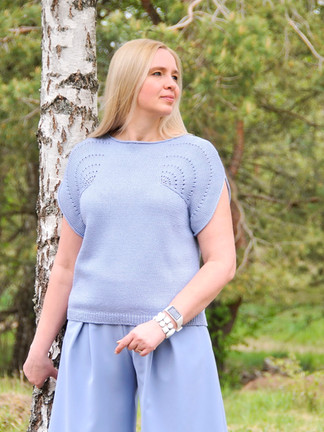




















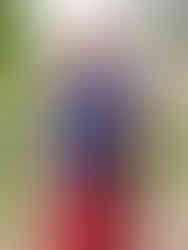


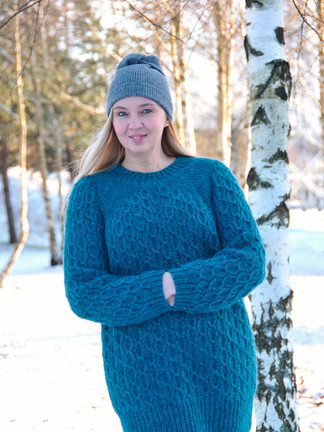















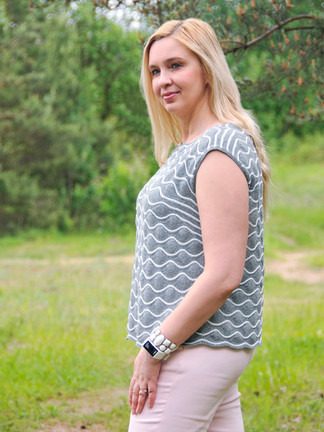







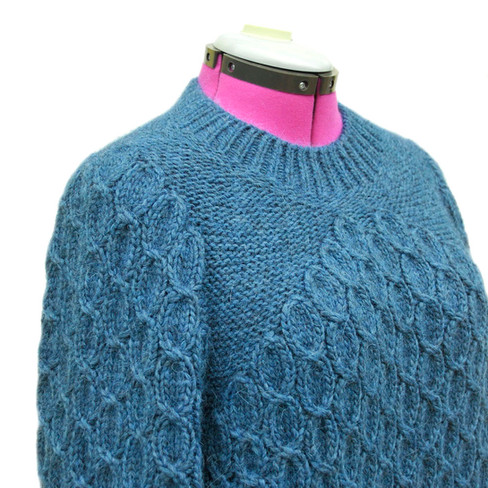








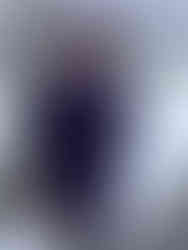












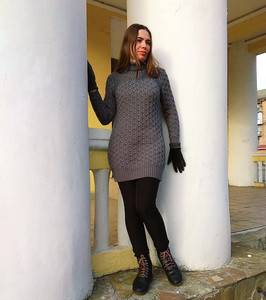







Великолепный Водопад! Великолепная кокетка! Понравилась такая имитация втачного рукава! Айсте, спасибо за познавательный и интересный рассказ о совмещении узоров и дизайнов! Инна, поздравляю с победой!
Айсте, спасибо!!!!! Я счастлива ! :) ( здесь много танцующих смайликов!)